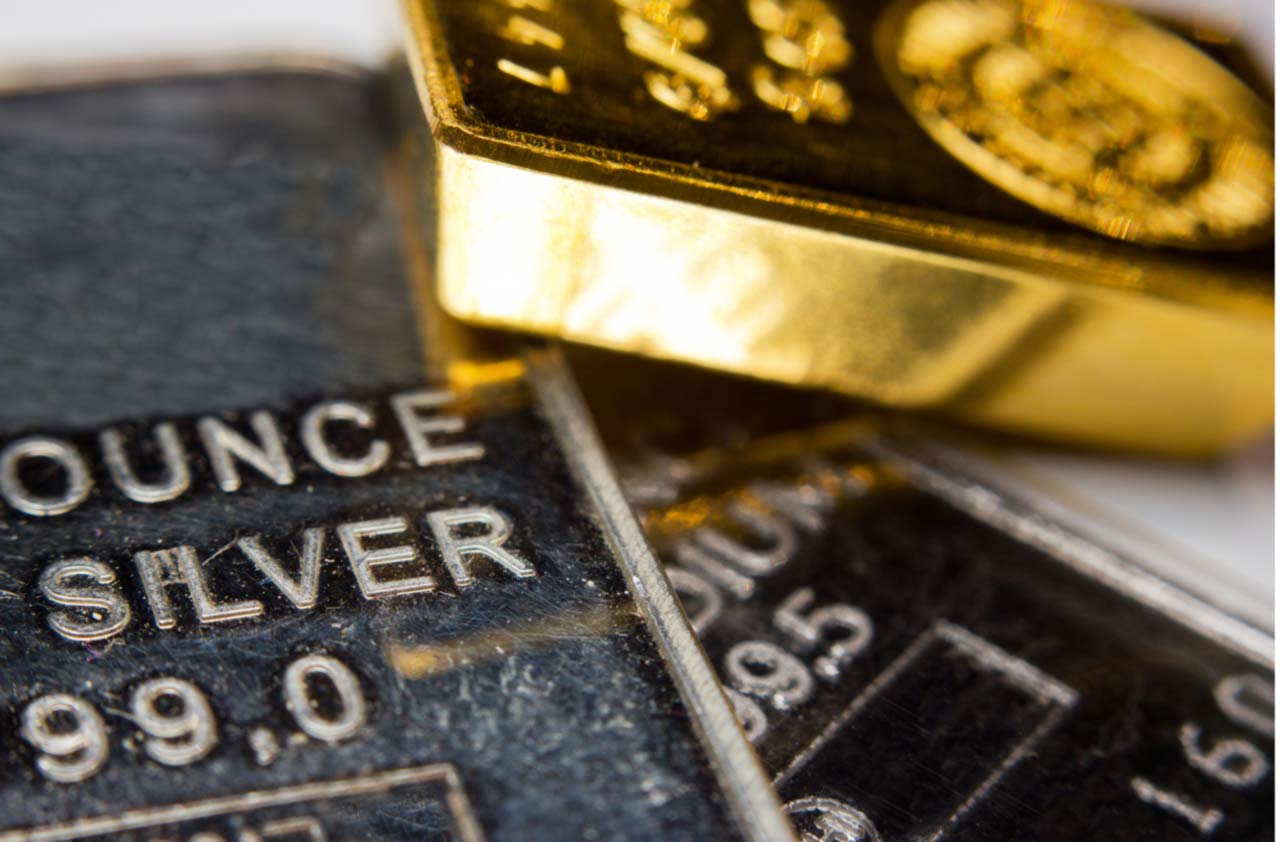Why Silver and Gold Look Shiny to Investors Right Now
While they have their downsides, precious metals offer a hedge in times of trouble and inflation. Now could be a good time to take a look.

With so much going on in the world these days, it’s easy to overlook the developments in the precious metal markets. Even as governments continue to devalue currencies, central banks across the globe have been accumulating gold. I think investors should start considering a small allocation in precious metals as well.
I realize that probably doesn’t sit well with many other advisers, who regard gold and silver as nothing more than shiny metal that sits in a vault, collecting dust and earning no interest or dividends.
But investors, in general, need to protect themselves from these currency devaluations, which will likely lead to inflation in the future. Even if we are currently in a deflationary environment, central banks continue to pursue inflation. I think they will, at some point be successful in achieving this goal. As such, a small allocation to precious metals could protect the purchasing power of your savings and insure your overall wealth.

Sign up for Kiplinger’s Free E-Newsletters
Profit and prosper with the best of expert advice on investing, taxes, retirement, personal finance and more - straight to your e-mail.
Profit and prosper with the best of expert advice - straight to your e-mail.
How much you should invest in precious metals, of course, depends on your portfolio and other factors. A good baseline for any investor interested in maintaining a small allocation in precious metals would be to keep a 10-to-1 ratio in mind. For these investors, every $10 you have in bonds or annuities should be matched by $1 invested in precious metals.
In the current global economic environment, precious metals look like a good short term-investment. Simply put, precious metals may be a good hedge for investors facing the myriad problems associated with the present economic environment, especially currency devaluation.
A diversified portfolio of tangible assets such as gold or silver should equal about 5% (and sometimes more) of an investor’s portfolio. That's a prudent asset-diversification strategy at any time. And in today's uncertain political and economic environment, there are many (and very sound) reasons to consider investing in precious metals to diversify your holdings.
Keep in mind, precious metals are not like other asset allocations. For example, putting money in precious metals is very different than investing in the stock market. Even the word “investment" seems a bit out of place here. Gold doesn’t pay dividends; gold doesn’t pay interest. It’s a metal that has historically been used as money. Throughout the world, gold continues to be recognized as money. As such, it offers long-term protection as our currency is devalued for investors looking to be able to maintain their lifestyles 10 to 15 years down the road.
I think silver is an even better option than gold for investors looking to diversify. Right now, the silver-to-gold price ratio is fairly high. Historically, that ratio has been 16-to-1; meaning 16 ounces of silver are valued the same as 1 ounce of gold. Right now, the ratio is far higher: 65 to 70 ounces of silver have the same dollar value as every ounce of gold. If history repeats itself, we should see that 16-to-1 ratio of silver to gold return in the near future. As such, I see far more upside with silver than I do with gold.
Allocating a portion of your assets in silver, at current prices, could offer investors and retirees one of the single best long-term investments available today. Along with gold, it is recognized as a store of value. What is not so well known is that, while gold has demonstrated a solid trend of price appreciation since 2001, more than quintupling in price, the price of silver has in the past outperformed gold.

Precious metals have been a safe haven in times of war, political strife and uncertainty. With the potential for rising inflation and the continued devaluation of paper currency as likely possibilities, I think it’s a good time to consider precious metals for your retirement portfolio.
The safest way to do that may be to own the metal outright. You can also consider gold and silver mining company’s such as Goldcorp (GG), Barrick Gold (ABX) and Newmont Mining (NEM) to name a few. For silver, consider First Majestic (AG), Silver Wheaton Corp. (SLW) and Pan American Silver Corp. (PAAS).
Kevin Derby contributed to this article.
Investment Advisory Services offered through Brookstone Capital Management LLC an SEC Registered Investment Adviser.
Get Kiplinger Today newsletter — free
Profit and prosper with the best of Kiplinger's advice on investing, taxes, retirement, personal finance and much more. Delivered daily. Enter your email in the box and click Sign Me Up.

Dr. Richard Pucciarelli is the president and founder of Carolina Retirement Resources Inc. He has over 15 years experience serving retirees and pre-retirees in planning for and protecting their financial futures. Pucciarelli is an Investment Adviser Representative and a licensed insurance professional. He hosts the "Financial Symphony" show on WBT Radio 1110 AM every Saturday morning at 11 a.m.
-
 The AI Doctor Coming to Read Your Test Results
The AI Doctor Coming to Read Your Test ResultsThe Kiplinger Letter There’s big opportunity for AI tools that analyze CAT scans, MRIs and other medical images. But there are also big challenges that human clinicians and tech companies will have to overcome.
By John Miley Published
-
 The Best Places for LGBTQ People to Retire Abroad
The Best Places for LGBTQ People to Retire AbroadLGBTQ people can safely retire abroad, but they must know a country’s laws and level of support — going beyond the usual retirement considerations.
By Drew Limsky Published
-
 Financial Planning's Paradox: Balancing Riches and True Wealth
Financial Planning's Paradox: Balancing Riches and True WealthWhile enough money is important for financial security, it does not guarantee fulfillment. How can retirees and financial advisers keep their eye on the ball?
By Richard P. Himmer, PhD Published
-
 A Confident Retirement Starts With These Four Strategies
A Confident Retirement Starts With These Four StrategiesWork your way around income gaps, tax gaffes and Social Security insecurity with some thoughtful planning and analysis.
By Nick Bare, CFP® Published
-
 Should You Still Wait Until 70 to Claim Social Security?
Should You Still Wait Until 70 to Claim Social Security?Delaying Social Security until age 70 will increase your benefits. But with shortages ahead, and talk of cuts, is there a case for claiming sooner?
By Evan T. Beach, CFP®, AWMA® Published
-
 Retirement Planning for Couples: How to Plan to Be So Happy Together
Retirement Planning for Couples: How to Plan to Be So Happy TogetherPlanning for retirement as a couple is a team sport that takes open communication, thoughtful planning and a solid financial strategy.
By Andrew Rosen, CFP®, CEP Published
-
 Market Turmoil: What History Tells Us About Current Volatility
Market Turmoil: What History Tells Us About Current VolatilityThis up-and-down uncertainty is nerve-racking, but a look back at previous downturns shows that the markets are resilient. Here's how to ride out the turmoil.
By Michael Aloi, CFP® Published
-
 Could You Retire at 59½? Five Considerations
Could You Retire at 59½? Five ConsiderationsWhile some people think they should wait until they're 65 or older to retire, retiring at 59½ could be one of the best decisions for your quality of life.
By Joe F. Schmitz Jr., CFP®, ChFC® Published
-
 Home Insurance: How to Cut Costs Without Losing Coverage
Home Insurance: How to Cut Costs Without Losing CoverageNatural disasters are causing home insurance premiums to soar, but don't risk dropping your coverage completely when there are ways to keep costs down.
By Jared Elson, Investment Adviser Published
-
 Markets Roller Coaster: Resist the Urge to Make Big Changes
Markets Roller Coaster: Resist the Urge to Make Big ChangesYou could do more harm than good if you react emotionally to volatility. Instead, consider tax-loss harvesting, Roth conversions and how to plan for next time.
By Frank J. Legan Published